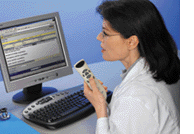
Let's face it: our profession is one of the last things out there that still uses handwriting on paper. We've all heard the benefits of an electronic patient record, but most hospitals are still state of the art 1975 when it comes to charting. This is a nice article about one clinic's success in the move from paper to digital.
While there are obvious benefits of a major computer upgrade, the real focus of the Mary Street project was converting to EMR. That was not a trivial undertaking.
“Mary Street went through a learning curve,” says Mitchell. He notes that there’s an inevitable performance hit, but that it quickly pays off. “You tend to lose twenty percent of your productivity the first month, ten percent in the second month, then break even in the third month. You then become very efficient.”
Dodds agrees that it took some effort to make the transition. “Different people within our clinic did it differently,” he notes.
“I’m one of the technophiles,” says Dodds. In particular, he types moderately well. So his own approach was to computerize everything he could. “I would go through the entire chart and try to archive it,” he recalls.
But even so, it was far from a trivial process. “How do you go from a paper chart to electronic records?” asks Dodds. Especially when that ‘chart’ may be a folder a half-inch thick... and you may have filing cabinets full of ones just like it? “It’s the single biggest issue with going electronic,” says Dodds. “You don’t just scan it all. You have to pick out what’s relevant.”
“We did a dual system for quite a while,” Dodds continues. Thus, the clinic opted to digitize old information as-needed, while keying new information directly into the new EMR system. The result was that after about four visits, most patients’ relevant information would end up in the EMR system.
Anything missing at that point can still be retrieved from the old paper folder and scanned in, as required. Fortunately, the scanning process is fairly efficient. “Scanning and OCRing [optical character recognition] are extremely fast and very accurate,” says Dodds.
At this point, the clinic is over the worst of the transition. “I get maybe one chart a week that we haven’t finished archiving,” he reports. Still, even now, when a patient is being sent to a surgeon, the full history needs to be dug out.
No comments:
Post a Comment